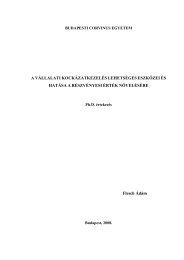római kori villák történeti - Budapesti Corvinus Egyetem
római kori villák történeti - Budapesti Corvinus Egyetem
római kori villák történeti - Budapesti Corvinus Egyetem
You also want an ePaper? Increase the reach of your titles
YUMPU automatically turns print PDFs into web optimized ePapers that Google loves.
SUMMARY. THE EXAMINATION OF THE HISTORICAL<br />
ENVIRONMENT OF ROMAN VILLAS ON THE BALATON<br />
HIGHLAND<br />
The Roman legions appeared in the Hungarian Transdanubia at the beginning of the 1 st<br />
century A. D.: they developed a border region from this area, Pannonia province, and they<br />
organized its independent administration. The economic boom of the Severus-era brought<br />
economical recovery into the life of the province in the 3 rd century, which also led the high<br />
growth of the number of the villas. These manors ensured the food supply of the army:<br />
beside its military role Pannonia was also the agricultural hinterland of the Roman Empire,<br />
thanks to the favorable natural conditions. The barbarians attacks were a permanent risk for<br />
the province, but because their recurring invasions more villas were confirmed in the 3-4 th<br />
century. Despite the military forces Pannonia province was slowly eliminated, however<br />
some villas could serve as residences or houses in the later ages too.<br />
The presence of the Romans in Pannonia caused several changes in the<br />
landscape: they wiped out forests, they brought the lands under cultivation, they built villas<br />
and towns with channels and paved streets: they were chosen the ideal places for buildings<br />
on the proximity of the water, the wood-giving forests using for houses and heatings, and<br />
the Roman road network, and they tried to involve in the spectable a panoramic view as<br />
beautiful as possible. The villas concentrated into five groups in Pannonia: by the rivers<br />
Dráva and Száva, by the Lake Fertő, beside the Mecsek mountain, beside the city of<br />
Aquincum, and the biggest group with nearly hundred villas and over hundred other rural<br />
settlements known today, was on the Balaton Highland.<br />
The villas were not holiday homes of the modern sense, but they were cultivation<br />
and stock-raising adapted farm units. Some uniformity can be observed in the external<br />
appearance of the villas, which basic criteria is a main building with bathroom, or a bath in<br />
a separated building, and a line of outbuildings. Nevertheless these manors were usually<br />
divided into three major parts: the so-called pars urbana was the residential area, and pars<br />
rustica with the pars fructuaria were the economical and storage part of the villas. These<br />
parts were often physically separated by thin walls and fences. Beyond the walls the fields<br />
of the farm-units, the grapes and the forest were located. This land, the so-called fundus or<br />
132

















